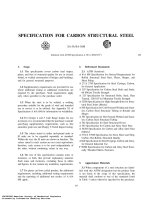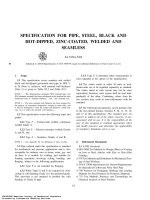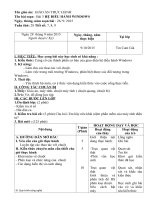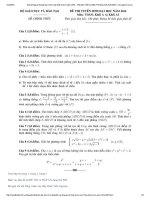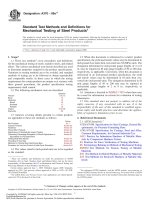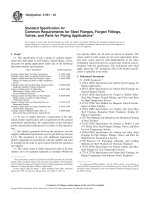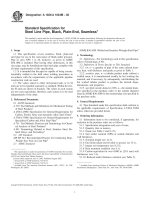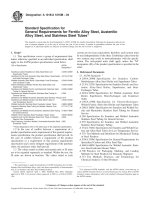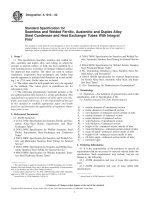Astm a 739 90a (2016)
Bạn đang xem bản rút gọn của tài liệu. Xem và tải ngay bản đầy đủ của tài liệu tại đây (71.57 KB, 2 trang )
Designation: A739 − 90a (Reapproved 2016)
Standard Specification for
Steel Bars, Alloy, Hot-Wrought, for Elevated Temperature or
Pressure-Containing Parts, or Both1
This standard is issued under the fixed designation A739; the number immediately following the designation indicates the year of
original adoption or, in the case of revision, the year of last revision. A number in parentheses indicates the year of last reapproval. A
superscript epsilon (´) indicates an editorial change since the last revision or reapproval.
This standard has been approved for use by agencies of the U.S. Department of Defense.
3.1.7 Additions to the specification, and
3.1.8 End use.
1. Scope
2
1.1 This specification covers hot-wrought, ferritic alloy
steel bars for elevated temperature or pressure-containing parts
suitable for fusion welding or both.
NOTE 1—A typical description is as follows: 10 000 lb, Ferritic Alloy
Steel Bars, Hot Wrought Normalized and Tempered, and Descaled,
1.000-in. diameter by 10 ft, ASTM A739 dated____, Grade B11, Special
Straightened, Special Machined Fittings.
1.2 The bars are furnished in the following grades:
Grade B 11: 1.25 % chromium, 0.55 % molybdenum
Grade B 22: 2.25 % chromium, 1.00 % molybdenum
4. Materials and Manufacture
4.1 Melting Practice—The steel shall be made by one or
more of the following primary processes: open-hearth, basicoxygen, or electric-furnace. The primary melting may incorporate separate degassing or refining and may be followed by
secondary melting using electroslag remelting or vacuum arc
remelting. Where secondary melting is employed, the heat
shall be defined as all of the ingots remelted from a single
primary heat.
1.3 The values stated in inch-pound units are to be regarded
as standard. The values given in parentheses are mathematical
conversions to SI units that are provided for information only
and are not considered standard.
2. Referenced Documents
2.1 ASTM Standards:3
A29/A29M Specification for General Requirements for Steel
Bars, Carbon and Alloy, Hot-Wrought
A370 Test Methods and Definitions for Mechanical Testing
of Steel Products
4.2 Condition—Unless otherwise specified, bars shall be hot
wrought, heat treated, and descaled.
4.3 Heat Treatment:
4.3.1 The bars shall be normalized and tempered.
4.3.2 Austenitizing temperature shall be within the range
from 1700 to 1800°F (927 to 982°C).
4.3.3 Cooling from the austenitizing temperature may be
accomplished by cooling in still air or moving air, at the
producer’s option. When permitted by the purchaser, cooling
from the austenitizing temperature may be accelerated by spray
or liquid quenching.
4.3.4 The minimum tempering temperature shall be 1200°F
(649°C) for Grade B11 and 1250°F (677°C) for Grade B22.
3. Ordering Information
3.1 Orders for material under this specification should
include the following information:
3.1.1 Quantity (weight or number of pieces),
3.1.2 Name of material (ferritic alloy steel bars),
3.1.3 Condition (hot wrought, normalized and tempered,
machine straightened and descaled),
3.1.4 Dimensions (cross-sectional shape, size, and length),
3.1.5 ASTM designation and date of issue,
3.1.6 Grade (Table 1),
5. Chemical Composition
5.1 The heat analysis shall conform to the limits for chemical composition specified in Table 1 for the grade ordered.
1
This specification is under the jurisdiction of ASTM Committee A01 on Steel,
Stainless Steel and Related Alloys and is the direct responsibility of Subcommittee
A01.15 on Bars.
Current edition approved Sept. 1, 2016. Published September 2016. Originally
approved in 1976. Last previous edition approved in 2012 as A739 – 90a (2012).
DOI: 10.1520/A0739-90AR16.
2
For ASME Boiler and Pressure Vessel Code applications see related Specification SA-739 in Section II of that code.
3
For referenced ASTM standards, visit the ASTM website, www.astm.org, or
contact ASTM Customer Service at For Annual Book of ASTM
Standards volume information, refer to the standard’s Document Summary page on
the ASTM website.
6. Mechanical Properties
6.1 Tensile Requirements—The bars as represented by the
test specimens shall conform to the tensile requirements
specified in Table 2.
6.2 Specimens—Tension test specimens shall be taken longitudinally and machined from the locations specified in Test
Methods and Definitions A370.
Copyright © ASTM International, 100 Barr Harbor Drive, PO Box C700, West Conshohocken, PA 19428-2959. United States
1
A739 − 90a (2016)
TABLE 1 Chemical Requirements
Element
Carbon, max
Manganese
Phosphorus, max
Sulfur, max
Silicon
Chromium
Molybdenum
laps, segregation, or other imperfections which, due to their
nature, degree or extent, will interfere with the use of the
material in machining or fabrication.
Composition, %
Grade B 11
Grade B 22
0.05–0.20
0.40–0.65
0.035
0.040
0.50–0.80
1.00–1.50
0.45–0.65
0.05–0.15
0.30–0.60
0.035
0.040
0.50 max
2.00–2.50
0.90–1.10
7.2 Descaling—Unless otherwise specified, the bars shall be
descaled.
8. General Requirements
8.1 Material furnished under this specification shall conform to the applicable requirements of the current edition of
Specification A29/A29M.
TABLE 2 Tensile Requirements
Tensile strength, ksi (MPa)
Yield strength, min, ksi (MPa)
Elongation in 2 in. or 50 mm,
min, %
Reduction of area, min, %
9. Certification and Test Reports
Grade B 11
Grade B 22
70.0–95.0 (483–655)
45.0 (310)
18
75.0–95.0 (517–655)
45.0 (310)
18
45
45
9.1 A manufacturer’s certification that the material was
manufactured and tested in accordance with this specification
together with a report of the analysis and tension test results
shall be furnished at the time of shipment. The report shall
include the name of the manufacturer, ASTM designation
number and year date and revision letter, if any, grade, heat
number, and size.
6.3 Number of Tests:
6.3.1 Two tension tests shall be made to represent bars of
the same size from each heat in each heat treatment charge. For
continuous heat-treated material, not fewer than two tension
tests shall represent a lot selected on the basis of one tension
test from each 10 000 lb (4500 kg).
6.3.2 When heat treated without interruption in continuous
furnaces, the material in a lot shall be from the same heat, same
prior condition, same size, and subjected to the same heat
treatments.
10. Product Marking
10.1 The bars shall be marked in accordance with Specification A29/A29M except as modified or supplemented by 10.2
through 10.4 of this specification.
10.2 When specified by the purchaser, the heat number shall
be permanently stamped on one end of each bar 2.50 in. and
larger in nominal diameter (or equivalent cross-sectional area).
10.3 The bars shall neither be hot nor cold stamped on the
sides unless approved by the purchaser on the purchase order.
6.4 Test Methods—Tension tests shall be made in accordance with Test Methods and Definitions A370. The yield
strength shall be determined by the 0.2 % offset method.
10.4 Each lift, regardless of size, shall be tagged with the
information required by Specification A29/A29M.
7. Workmanship, Finish, and Appearance
11. Keywords
7.1 Workmanship—The bars shall be free of pipe, cracks,
and flakes. Within the limits of good manufacturing and
inspection practices the bars shall be free of injurious seams,
11.1 alloy steel bars; high-temperature applications; hotwrought steel bars; pressure-containing parts; steel bars; temperature service application—high
ASTM International takes no position respecting the validity of any patent rights asserted in connection with any item mentioned
in this standard. Users of this standard are expressly advised that determination of the validity of any such patent rights, and the risk
of infringement of such rights, are entirely their own responsibility.
This standard is subject to revision at any time by the responsible technical committee and must be reviewed every five years and
if not revised, either reapproved or withdrawn. Your comments are invited either for revision of this standard or for additional standards
and should be addressed to ASTM International Headquarters. Your comments will receive careful consideration at a meeting of the
responsible technical committee, which you may attend. If you feel that your comments have not received a fair hearing you should
make your views known to the ASTM Committee on Standards, at the address shown below.
This standard is copyrighted by ASTM International, 100 Barr Harbor Drive, PO Box C700, West Conshohocken, PA 19428-2959,
United States. Individual reprints (single or multiple copies) of this standard may be obtained by contacting ASTM at the above
address or at 610-832-9585 (phone), 610-832-9555 (fax), or (e-mail); or through the ASTM website
(www.astm.org). Permission rights to photocopy the standard may also be secured from the Copyright Clearance Center, 222
Rosewood Drive, Danvers, MA 01923, Tel: (978) 646-2600; />
2
